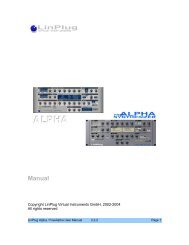CrX4 User Manual - LinPlug Virtual Instruments
CrX4 User Manual - LinPlug Virtual Instruments
CrX4 User Manual - LinPlug Virtual Instruments
You also want an ePaper? Increase the reach of your titles
YUMPU automatically turns print PDFs into web optimized ePapers that Google loves.
The Main Section<br />
In the Main section you find a couple of global settings: The Chord Memory,<br />
Velocity to Amplitude modulation, Precision, polyphony (Voice Limit), the<br />
Glide parameters and the main Amplitude Envelope.<br />
Chord Memory<br />
The Chord (Chord Memory) function allows you to record chords and<br />
include them with the current preset. The idea behind it is, to trigger<br />
multiple notes which can be interesting sound effects, often when using the<br />
Arpeggiator to break this chord into many, successively played notes.<br />
The Chord button has three states:<br />
– the left state (single note), means Chord memory is Off<br />
– the middle state (a red chord) means you are in Learn mode and<br />
can now record a simple two notes chord up to a 8 note complex<br />
chord.<br />
– The right state (a green chord) means that Chord memory is On,<br />
turning every Note message into the chord which was previously<br />
recorded.<br />
Note that the order in which notes are played in Learn Mode is important:<br />
the first note is taken as the root or basic note and all successive notes are<br />
stored by interval relative to this first note. For example, if you learn the<br />
chord C-E-G by actually playing the E first, the C is stored as -4 semitones<br />
and the G as +3 semitones.<br />
This means that if you play a C note when in Play mode after recording the<br />
chord from the above example, the resulting chord will be G#-C-D#.<br />
<strong>CrX4</strong> <strong>User</strong> <strong>Manual</strong> 28












